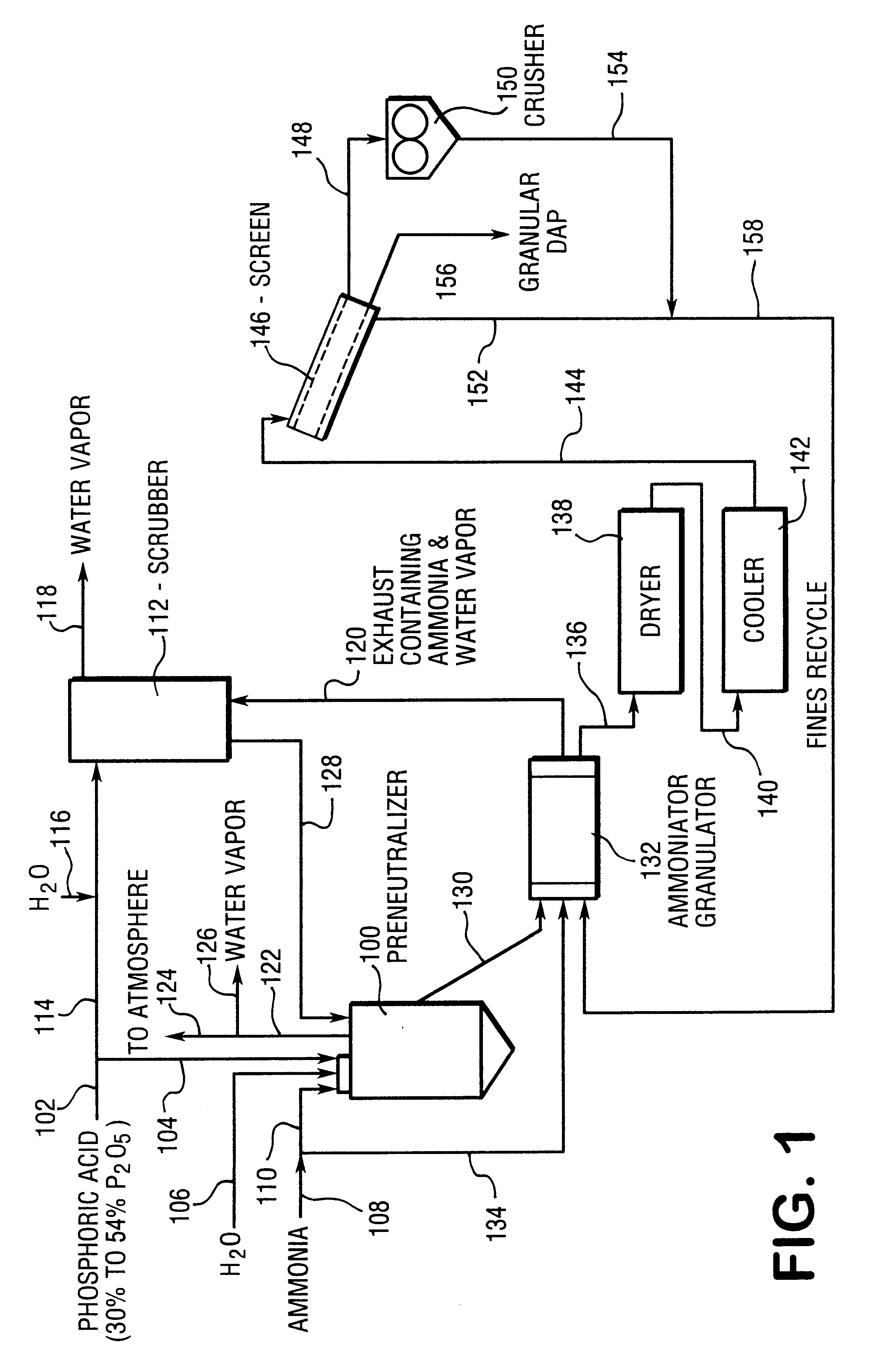Method for producing fertilizer grade DAP having an increased nitrogen concentration from recycle
a technology of fertilizer grade dap and recycling, which is applied in the direction of application, phosphorus oxyacids, ammonium orthophosphate fertilisers, etc., can solve the problems of increasing the amount of added nitrogen, gaining excessive moisture, and tend to lose significant amounts of nitrogen, so as to improve the distribution of slurry and reduce the solubility
- Summary
- Abstract
- Description
- Claims
- Application Information
AI Technical Summary
Benefits of technology
Problems solved by technology
Method used
Image
Examples
example b
DAP dust, from the dryer in a conventional TVA process, was exposed to a 100 percent ammonia atmosphere at pressures from 15 psia to 90 psia. The DAP dust used in these tests was not mixed with any other DAP material. The size distribution of the DAP dust is shown below:
The remaining portion of the dust (25.04 percent) passed through the 200 mesh sieve and was, thus, smaller than 74 microns. Contact times between the dust and the ammonia was 1 hour 40 minutes for test sample number B-1 and was 45 minutes for sample numbers B-2 to B-7. The results of these tests (DAP dust) are set forth in Table 3. The reasoning behind these tests was that the nitrogen enriched dust could be coated with slurry in the granulator and incorporated into the DAP product. The slurry was partially neutralized phosphoric acid, at a temperature of about 240.degree. F., with an N / P mole ratio of about 1.4:1 to 1.6:1 and the following typical analysis: 43.4 percent P.sub.2 O.sub.5, 13.5 percent N, 13.5 percent ...
example c
A number of pressure ammoniation tests were run with DAP dust, which was from the dryer in a conventional TVA process, to determine the effect of contact time on nitrogen adsorption. Contact times from 0.25 to 30 minutes were investigated at ammonia pressures from 15 to 45 psia. The DAP dust in these tests were not mixed with any other DAP material. The dust had a particle size of -80 mesh. As with all of the tests in these examples, the air in the reactor was evacuated before pressurizing with ammonia. Moisture analyses were also run on all of the samples prior to the ammonia treatment. The results of this test series (DAP) are set forth in Table 4.
Notes:
(1) Sample Nos. C-6, C-9, C-15 and C-25 each had sufficient water added to reach the initial percent moisture indicated.
(2) Sample No. C-5 was a mixture of dust samples and was humidified to reach the initial percent moisture indicated.
The results from these tests indicate that nitrogen adsorption is a function of ammonia pressure,...
example d
This example illustrated the results of pressure ammoniation tests run with DAP recycle material from a conventional TVA process. The DAP recycle material comprises a combination of dust, undersize particles (-9 mesh) and crushed oversize particles. Where samples of actual recycle going to the granulator could not be collected, separate samples (D-I and D-II) of the three-size fractions were collected and blended. The blending ratio in these samples (D-I and D-II) was one part of dust, three parts of crushed oversize particles and parts of undersize particles. For sample D-III, the actual recycle going to the granulator was used. However, for all experiments, the actual recycle or simulated recycle was screened on a 9 mesh screen; and any oversize particles which did not pass through the screen were ground (to pass the 9 mesh screen) and combined with the original sample. The recycle screen analysis for samples D-I, D-II and D-III are set forth in Table 5.
Note: 1. Percent passing th...
PUM
| Property | Measurement | Unit |
|---|---|---|
| pressure | aaaaa | aaaaa |
| absolute pressure | aaaaa | aaaaa |
| absolute pressure | aaaaa | aaaaa |
Abstract
Description
Claims
Application Information
 Login to View More
Login to View More - R&D
- Intellectual Property
- Life Sciences
- Materials
- Tech Scout
- Unparalleled Data Quality
- Higher Quality Content
- 60% Fewer Hallucinations
Browse by: Latest US Patents, China's latest patents, Technical Efficacy Thesaurus, Application Domain, Technology Topic, Popular Technical Reports.
© 2025 PatSnap. All rights reserved.Legal|Privacy policy|Modern Slavery Act Transparency Statement|Sitemap|About US| Contact US: help@patsnap.com



